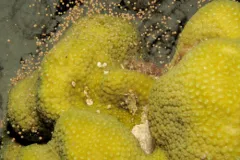A Tale of Sex and Stress in the Ocean

Welcome to Citizens of the Sea, a new blog series where ocean life comes to life. Our book by the same name came out in September, but no sooner had it gone off to the printer than new ocean stories started streaming in. So every other week, we’ll use this series to explore some interesting aspect of marine life forms and their weird and wonderful ways of getting by.
We’d like to start with a personal story about the reefs of Panama near the Smithsonian Tropical Research Institute where we recently spent 10 days studying coral spawning. Corals reproduce both sexually and asexually. A colony gets bigger by “budding” off new polyps (tiny identical coral individuals) each lined with a ring of tentacles surrounding a mouth on top, which is connected to the gut and gonads below. Often the polyps stay together as a colony. But big storms (or even normal wear and tear) sometimes cause a colony to break up into pieces, which can reattach to the bottom and start a new colony. So in theory corals could simply grow bigger by budding and skip sex altogether.
But for corals, reproduction isn’t always a solitary affair. Like almost all other organisms, corals regularly mix their genes with other members of the same species. Small coral species often do this on a lunar cycle several times a year. Sperm released into the water by one colony moves across the reef and is picked up by another colony and used to fertilize its eggs, which develop for a bit before being released. These “brooders” can also often self-fertilize if need be, which comes in handy if you’re the only coral on the block. But long-lived coral species, the primary builders of reefs, usually engage in sex just once a year and must cross fertilize (that is, their eggs must mix with sperm from another colony). Which is why we were swimming around a reef in Bocas del Toro, Panama, a few nights after the September full moon, flashlights in hand, looking for the telltale pink bundles of eggs and sperm that are expelled through the polyps’ mouths.
We saw a few colonies release their bundles, but far fewer than in past years. Most of the colonies in shallow water and quite a few in deeper water were bone white. Thanks to the unusually warm water these “bleached” colonies had lost all the single-celled algae (called zooxanthellae) that normally give corals their color and photosynthesize much of their food. Almost none of these bleached corals spawned, a troubling development given that bleaching will likely be an increasingly regular occurrence in our warming world.
In fact, the bleached colonies we observed are part of a larger regional bleaching event affecting a wide swath of the Western Caribbean. Elsewhere in the bay of Bocas del Toro, even more ominous changes have occurred since our last visit. Oxygen has left deeper waters altogether for reasons that remain unclear, and we found a reef that was vibrantly colorful last year now covered with a thick, bleakly gray, bacterial slime.
We hadn’t intended to start with such a bleak story, and we won’t make doom and gloom the dominant theme of this series. So we promise something fun and different for the next post, in two weeks, when we’ll talk about how sharks (and other sea creatures) smell in stereo!
Editors Note: This post was co-written with Amanda Feuerstein, program coordinator in the office of the Sant Chair for Marine Science. Dr. Nancy Knowlton is the Sant Chair for Marine Science at Smithsonian’s National Museum of Natural History. Their blog series is based on Dr. Knowlton's book Citizens of the Sea, which celebrates “the Wondrous Creatures from the Census of Marine Life.”

